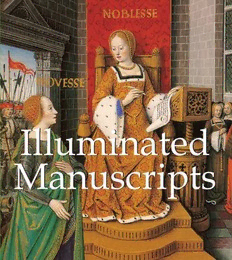
Illuminated Manuscripts PDF
Preview Illuminated Manuscripts
IIlllluummiinnaatteedd MMaannuussccrriippttss Text: Tamara Woronowa and Andrej Sterligow Layout: Baseline Co Ltd 127-129A Nguyen Hue Fiditourist 3rdFloor District 1, Ho Chi Minh City Vietnam © Sirrocco, London, UK © Confidential Concepts, Worldwide, USA All rights reserved No part of this publication may be reproduced or adapted without the permission of the copyright holder, throughout the world. Unless otherwise specified, copyright on the works reproduced lies with the respective photographers. Despite intensive research, it has not always been possible to establish copyright ownership. Where this is the case, we would appreciate notification. Editor’s note: The countries indicated in the captions refer to the place of origin of the works and not to their current location. As regards the dimensions indicated, they are linked, unless mentioned otherwise, to the volume. ISBN: 978-1-78042-088-2 2 “The gilding [of the illumination], the brightness of its colour are not the result of a ‘medieval naivety‘ but they are the means of creation of another world.” – André Malraux 3 Avicenna and the Translator of his Work, Represented by a Monk Below (Initial of book 3) Canon, Ibn-Cina (Avicenna), 1343 Parchment, Latin, 42 x 26 cm, Italy 4 Chronology 15th Century B.C.E.: First illuminated manuscripts of papyrus in Ancient Egypt. 2nd Century: Creation of the codex (bound book). The codex that will not truly supplant the scroll(a roll of parchment or paper) until the 4th century. More hard-wearing, the parchment, elaborated with animal skin, will replace the papyrus. 6th Century: First illuminated manuscripts in the codexof Western monasteries. 6th Century-8th Century: The “insular art” (“of the islands of” Ireland and Northumbria) stands out by the creativeness of its Gospel adornements, with designs of plants and mosaics. The Merovingian manuscripts of linear style are modelled on Antiquity and Byzantine art to illustrate prayer books and lectionaries. The main centers of production are the monasteries of Fleury, Tours (Val de Loire), Luxeuil (Burgundy) and Corbie (Picardy). 8th Century: The work of the first British historian, Bede the Venerable (c. 673-735), entitled Historia Ecclesiastica Gentis Anglorum introduced for the first time an historiated initial in a manuscript. 8th Century-10th Century: Carolingian Renaissance: setting of the main principles of the art of illuminated manuscripts. Rationalising the decor (naturalistic figural art), focused on the initial capital and a few miniatures. Enriching of the material: prepared manuscript with purple background, decor of gold and silver (The Purple Gospelbook). The thematic of the codex spreads to profane texts (Bestiary). Flourishing art at the court of Charles the Bald (Sacramentaryof Saint-Amand), but in other places as well as the Rhine Valley, Tours, Rheims and Metz. 5 St Thomas Aquinas Teaching Summae Theologiae, Thomas Aquinas Mid-15th century, Parchment, Latin, 30 x 20.5 cm France (Paris?) 6 13th Century: The French illuminated manuscripts set the laws of the Gothic style for the whole Western world. Keen interest on architectural forms, brights colours (blue, red, white), quest for the volume and movement (Psalter, 1218-1242). Creation of full-page miniatures. The ornementation gains margins which become populated with ivy, grotesques and drolleries. The era of monastic fabrication declines with the advent of urban workshops run by laymen. 14th Century: Refinement of the silhouettes and elegance of the Parisian School, under the direction of Jean de Pucelle. Flourishing of the illuminated manuscript art in Provence and Catalonia, strongly influenced by oriental taste (Lo Breviari d’amor). In Italy, the illuminated manuscripts of Bologna are done according to the teaching of Giotto: coloured tints, details and perspective (Story of the Trojan War). Straightness of the Germanic-style figures (Book of Chess). Famous Flemish artists (such as the Limburg Brothers, The Very Rich Hours of the Duke of Berry) are drawn by the enlightened patronage of Charles V, the Dukes of Burgundy, the Dukes of Berry and of the Valois Princes. 15th Century: Immersed in the Hundred Years’ War, France loses its creative dynamism. The Duchy of Burgundy of Philip the Good welcomes French artists (Simon Marmion, the presumed author of the Chronicles of France of Saint-Bertin) and Flemish artists as well (Universal Chronology). The Italian illumination develops with the spread of humanist books under the patronage of the Sforza and of the Medici (Canzoniereof Petrarch). Creative turmoil at King Rene’s court, he was a lover of art and humanist principles. Jean Fouquet restores the prestige of French illuminated manuscripts in a Renaissance language (Book of Hours of Etienne Chevalier). 16th Century: Diffusion of the printed book: decline of the manuscript production and the art of illumination. Surviving of the Instructionsand Portulans of Venice. Books illustrations gradually gave way to the principles of easel painting. 7 nyone fortunate enough to have actually held a A medieval manuscript in his hands must have felt excited at this immediate contact with the past. Both famous and unknown authors wrote philosophical, natural scientific and theological treatises; romances about knights and courtly love; humanists and theologists translated and commented upon the classical literature of antiquity; travellers wrote descriptions of their incredible journeys and ascetic chroniclers recorded and kept alive the historic events of their times for future generations. St Jerome (Frontispiece) Epistles of St Jerome (Hieronymi Epistolae) c. 700 Parchment, Latin, 20.9 x 15.2 cm France (Corbie) 8 9 One can imagine a scribe constantly at work in a shop in some quiet narrow street of a medieval town, or a monk diligently reproducing the words of Holy Writ over and over again in a monastery scriptorium. Even in those rare cases when a building decorated with frescoes has survived without having been damaged and having had its murals painted over in the course of successive ages at the whim of changing tastes, fluctuating temperatures and the effects of the atmosphere have substantially altered the original colour of the works. Opening Page with Historiated Initial (probably Pope Gregory the Great) Ecclesial History of the English People (Historia Ecclesiastica Gentis Anglorum) The Venerable Bede 746 Parchment, Latin, 27 x 19 cm Northumbia 10
